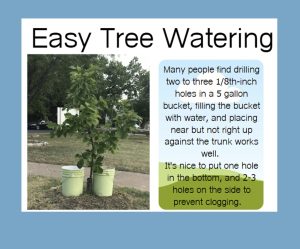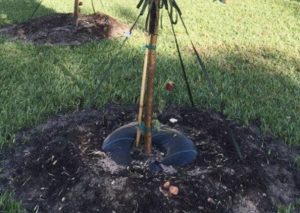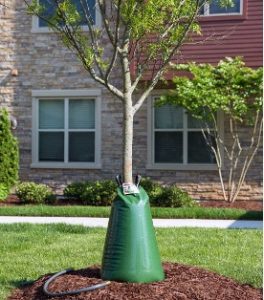 As water restrictions tighten, it’s important to know not just when to water, but also how to do it effectively. A logical place to look for direction is urban forester Kelly Eby, head of the city’s Community Forestry Program. As the person responsible for the health of trees and other vegetation on more than 2004 acres, Eby has a variety of watering methods in her repertoire. What all of them have in common is the goal of releasing water slowly in order to encourage infiltration and to avoid runoff.
As water restrictions tighten, it’s important to know not just when to water, but also how to do it effectively. A logical place to look for direction is urban forester Kelly Eby, head of the city’s Community Forestry Program. As the person responsible for the health of trees and other vegetation on more than 2004 acres, Eby has a variety of watering methods in her repertoire. What all of them have in common is the goal of releasing water slowly in order to encourage infiltration and to avoid runoff.
To begin, Eby says she uses a Google doc to keep track of what gets done. Even in a home landscape, remembering what has been watered and what hasn’t can be tricky, so developing a system to avoid over or underwatering is a good idea.
Depending on the number of staff and volunteers she has available, Eby has a variety of tools at her disposal. In the cemetery, she says, she likes to use the big blue barrels that hold a lot of water for larger trees. More commonly, though, she uses plastic buckets into which she’s drilled small holes. “I like to use these because I can better estimate how much water I have applied to the tree,” Eby says. “The water soaks in slowly and is less likely to run off.” Sometimes, she adds, it’s possible to find these buckets at barbecue restaurants, which purchase them filled with pickles or potato salad.
Other methods and devices she’s used:
 TreeDiapers—The TreeDiaper is a patented product developed in 2015 by two new parents looking for a way to make recyclable diaper material. They succeeded, but when the invention went nowhere, they looked for a different application for their discovery. The result was the TreeDiaper, a mat made from plastic fabrics and a super absorbent polymer. Available in numerous shapes and sizes, the TreeDiaper works by catching, retaining, and releasing rain and/or irrigation water. “I like how they hold moisture,” says Kelly Eby, “but they need to be recharged, and that’s hard when I have lots of trees.”
TreeDiapers—The TreeDiaper is a patented product developed in 2015 by two new parents looking for a way to make recyclable diaper material. They succeeded, but when the invention went nowhere, they looked for a different application for their discovery. The result was the TreeDiaper, a mat made from plastic fabrics and a super absorbent polymer. Available in numerous shapes and sizes, the TreeDiaper works by catching, retaining, and releasing rain and/or irrigation water. “I like how they hold moisture,” says Kelly Eby, “but they need to be recharged, and that’s hard when I have lots of trees.”
 Treegator—Made from reinforced, UV treated 10 mil polyethylene, Treegator was developed in 1989 in Woodbine, MD, for use in a nursery. Designed for trees from 1 to 8 inches in diameter, this product is available in a range of sizes, holding from 14.25 to 25 gallons of water and emptying in 5 to 9 hours. “Gator bags are easy for volunteers to use,” Kelly Eby explains, adding that they eliminate guesswork when it comes to calculating the amount of water used.
Treegator—Made from reinforced, UV treated 10 mil polyethylene, Treegator was developed in 1989 in Woodbine, MD, for use in a nursery. Designed for trees from 1 to 8 inches in diameter, this product is available in a range of sizes, holding from 14.25 to 25 gallons of water and emptying in 5 to 9 hours. “Gator bags are easy for volunteers to use,” Kelly Eby explains, adding that they eliminate guesswork when it comes to calculating the amount of water used.
Irrigation—”Irrigation is helpful, but hard when extreme heat shrinks the soil and causes breaks,” admits Kelly Eby. Another drawback to using automatic irrigation systems is that during Stage 3 water restrictions, this type of watering is allowed only once every other week. In contrast, drip irrigation is currently allowed any day during designated usage times.
OTHER RESOURCES
- Treegator: http://treegator.com.pl/en/produkty/treegator-original
- TreeDiaper: https://www.treediaper.com
- Methods for watering plants when you’re away: https://www.youtube.com/watch?v=pQc3yENYuSk
- “7 Tips for Watering Your Garden: https://www.youtube.com/watch?v=OOLgbkq_P4Y
- Friends of Trees, City of San Marcos: https://sanmarcostx.gov/3272/Friends-of-Trees
Written by Susan Hanson, editor, The Loop.
